Abstract
Diets deficient in the omega-6 fatty acid linoleic acid reduce arachidonic acid (Ach) concentrations and retard growth of developing animals and humans. Nevertheless, plasma phosphatidylcholine Ach concentrations declined from 84 +/- 23 mg/liter at birth to a nadir of 38 +/- 11 mg/liter at 4 mo of age in preterm infants fed commercial formulas with linoleic acid, and weight normalized to that of term infants fell progressively beginning at 2 mo of age. The nadir of plasma phosphatidylcholine Ach (31 +/- 7 mg/liter) and growth were further reduced by formula containing marine oil compared with the commercial formulas. Ach status (defined as the mean plasma phosphatidylcholine Ach concentration at 2, 4, and 6.5 mo) correlated with one or more measures of normalized growth through 12 mo. Ach status and maternal height accounted for as much as 59% of the weight variance and 68% of the length variance in infants fed standard formulas. Better Ach status was not from higher energy intakes. A conditional Ach deficiency in preterm infants may contribute to growth over the first year of life. On the strength of the relationship between Ach status and growth, we hypothesize that dietary Ach could improve first year growth of preterm infants.
Full text
PDF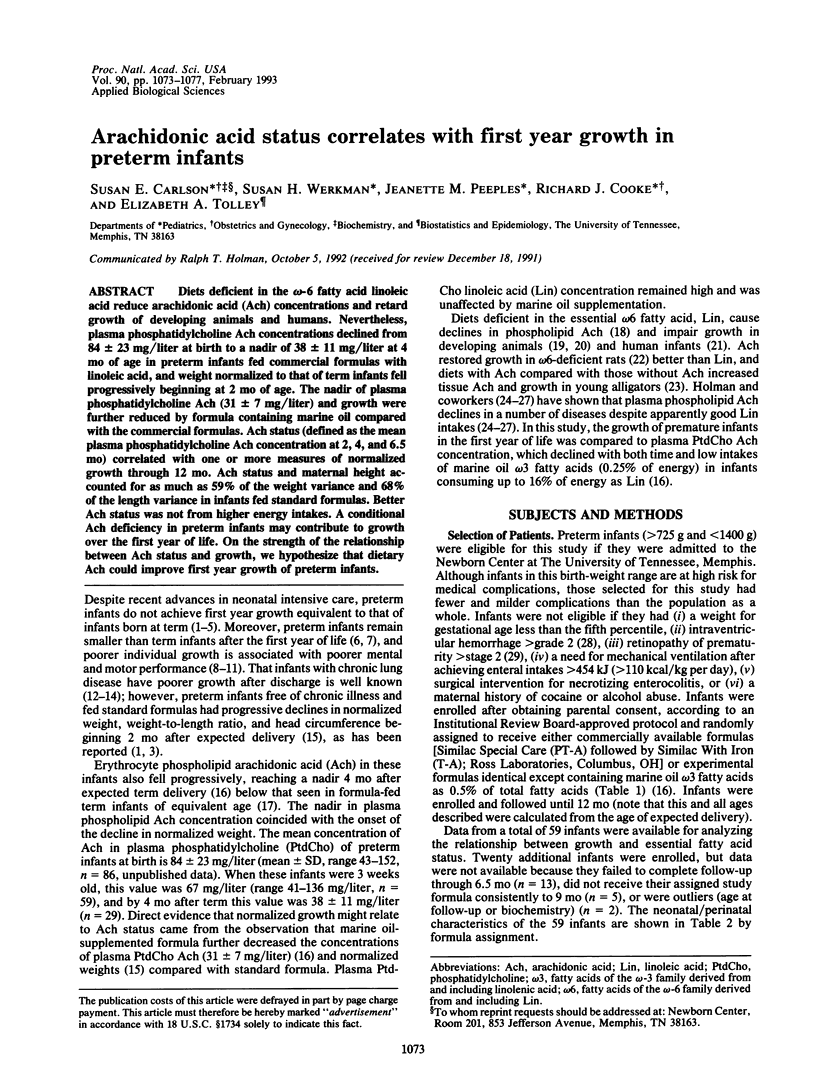
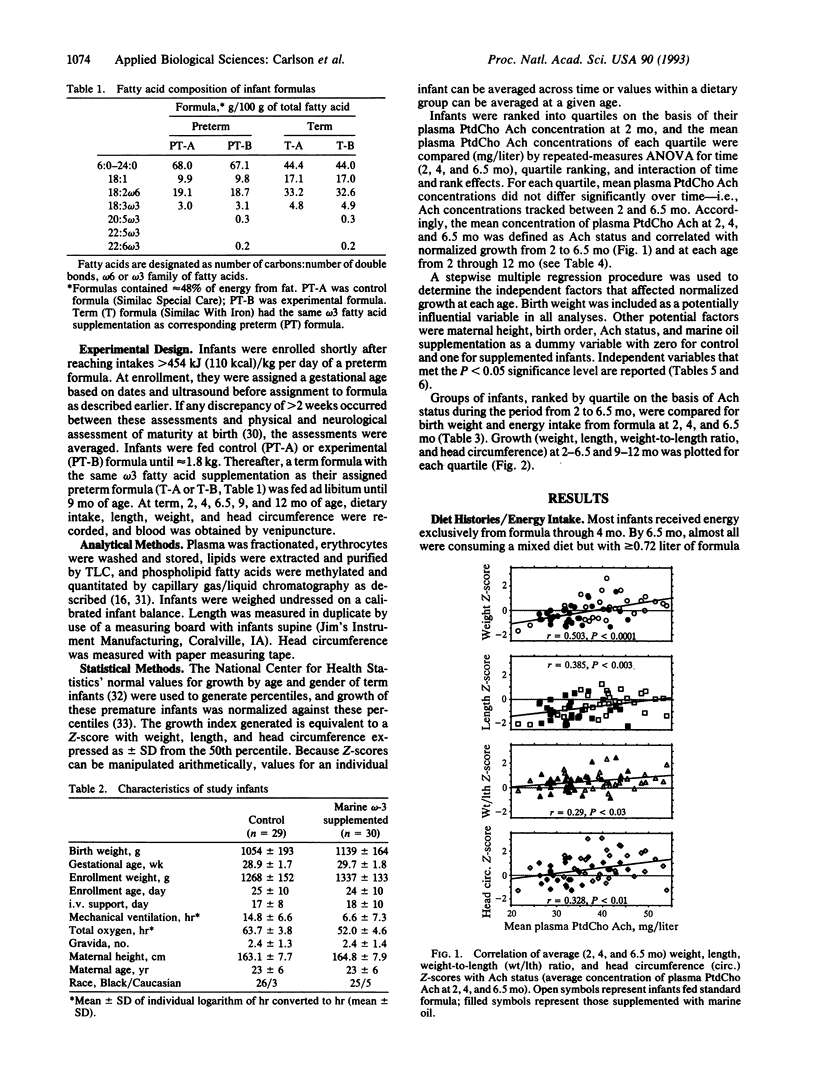
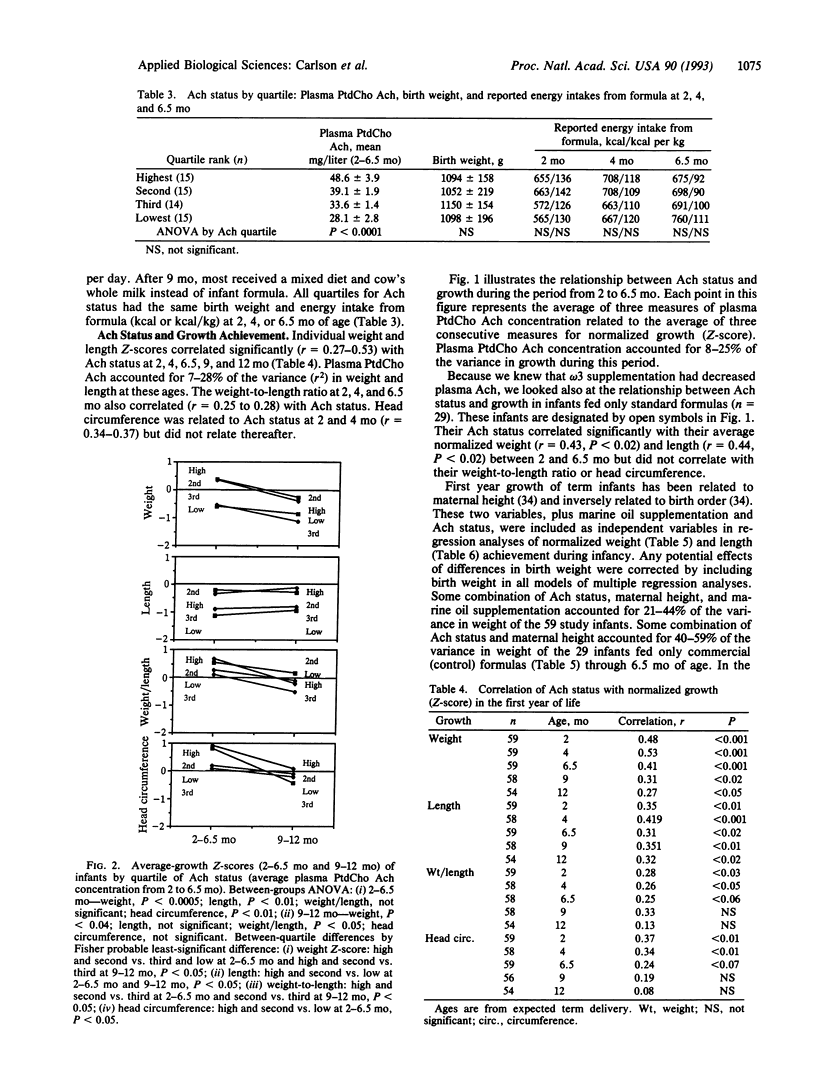
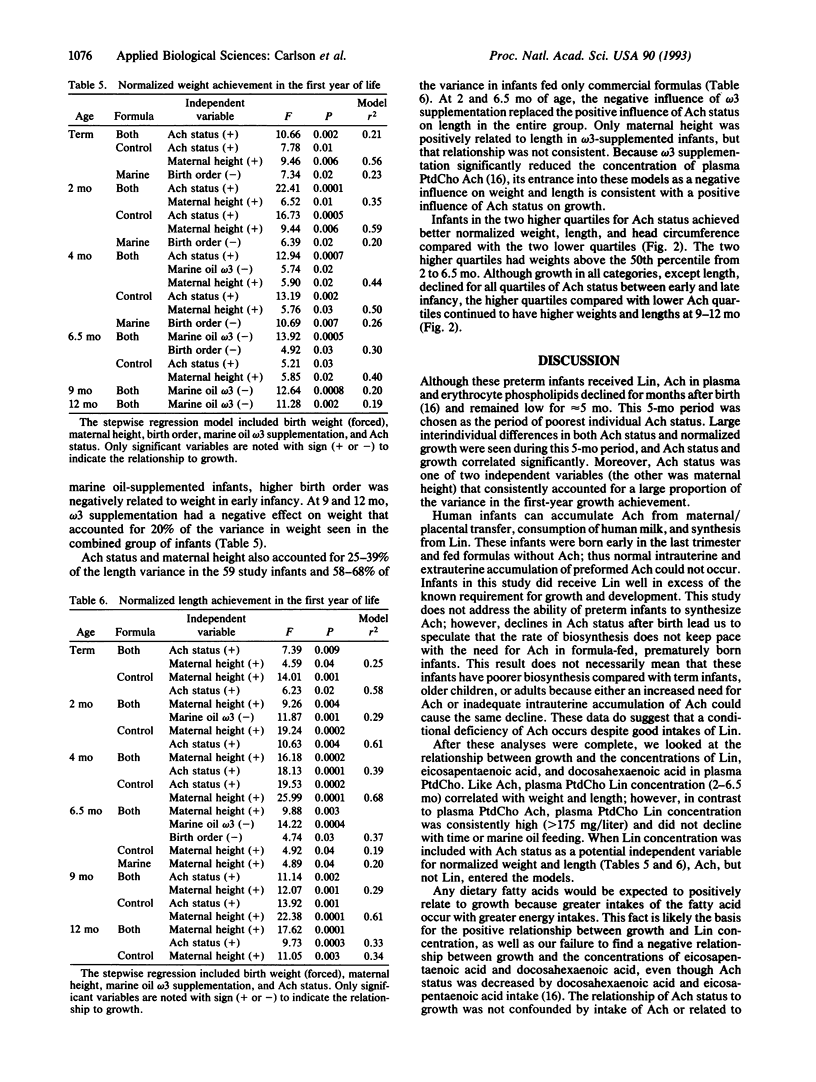
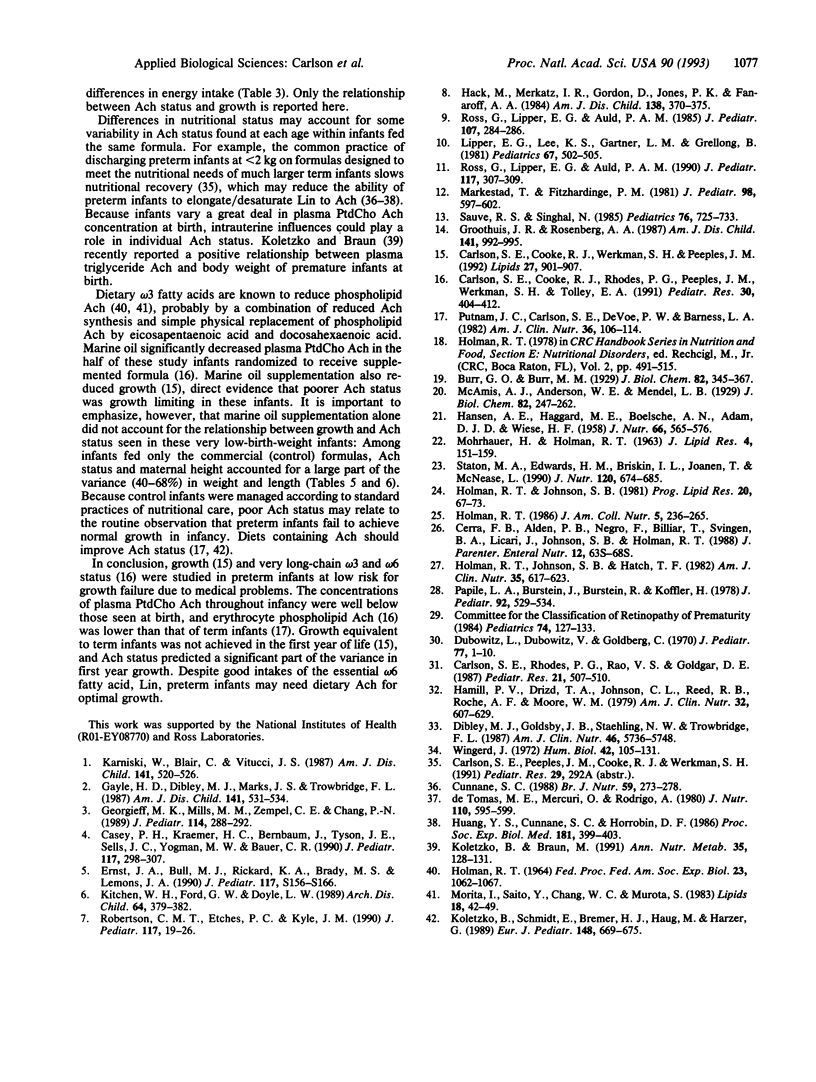
Selected References
These references are in PubMed. This may not be the complete list of references from this article.
- Carlson S. E., Cooke R. J., Rhodes P. G., Peeples J. M., Werkman S. H., Tolley E. A. Long-term feeding of formulas high in linolenic acid and marine oil to very low birth weight infants: phospholipid fatty acids. Pediatr Res. 1991 Nov;30(5):404–412. doi: 10.1203/00006450-199111000-00003. [DOI] [PubMed] [Google Scholar]
- Carlson S. E., Cooke R. J., Werkman S. H., Tolley E. A. First year growth of preterm infants fed standard compared to marine oil n-3 supplemented formula. Lipids. 1992 Nov;27(11):901–907. doi: 10.1007/BF02535870. [DOI] [PubMed] [Google Scholar]
- Carlson S. E., Rhodes P. G., Rao V. S., Goldgar D. E. Effect of fish oil supplementation on the n-3 fatty acid content of red blood cell membranes in preterm infants. Pediatr Res. 1987 May;21(5):507–510. doi: 10.1203/00006450-198705000-00017. [DOI] [PubMed] [Google Scholar]
- Casey P. H., Kraemer H. C., Bernbaum J., Tyson J. E., Sells J. C., Yogman M. W., Bauer C. R. Growth patterns of low birth weight preterm infants: a longitudinal analysis of a large, varied sample. J Pediatr. 1990 Aug;117(2 Pt 1):298–307. doi: 10.1016/s0022-3476(05)80551-7. [DOI] [PubMed] [Google Scholar]
- Cerra F. B., Alden P. A., Negro F., Billiar T., Svingen B. A., Licari J., Johnson S. B., Holman R. T. Sepsis and exogenous lipid modulation. JPEN J Parenter Enteral Nutr. 1988 Nov-Dec;12(6 Suppl):63S–68S. doi: 10.1177/014860718801200606. [DOI] [PubMed] [Google Scholar]
- Cunnane S. C. Evidence that adverse effects of zinc deficiency on essential fatty acid composition in rats are independent of food intake. Br J Nutr. 1988 Mar;59(2):273–278. doi: 10.1079/bjn19880034. [DOI] [PubMed] [Google Scholar]
- De Tomás M. E., Mercuri O., Rodrigo A. Effects of dietary protein and EFA deficiency on liver delta 5, delta 6 and delta 9 desaturase activities in the early developing rat. J Nutr. 1980 Apr;110(4):595–599. doi: 10.1093/jn/110.4.595. [DOI] [PubMed] [Google Scholar]
- Dubowitz L. M., Dubowitz V., Goldberg C. Clinical assessment of gestational age in the newborn infant. J Pediatr. 1970 Jul;77(1):1–10. doi: 10.1016/s0022-3476(70)80038-5. [DOI] [PubMed] [Google Scholar]
- Ernst J. A., Bull M. J., Rickard K. A., Brady M. S., Lemons J. A. Growth outcome and feeding practices of the very low birth weight infant (less than 1500 grams) within the first year of life. J Pediatr. 1990 Aug;117(2 Pt 2):S156–S166. doi: 10.1016/s0022-3476(05)80014-9. [DOI] [PubMed] [Google Scholar]
- Gayle H. D., Dibley M. J., Marks J. S., Trowbridge F. L. Malnutrition in the first two years of life. The contribution of low birth weight to population estimates in the United States. Am J Dis Child. 1987 May;141(5):531–534. doi: 10.1001/archpedi.1987.04460050073034. [DOI] [PubMed] [Google Scholar]
- Georgieff M. K., Mills M. M., Zempel C. E., Chang P. N. Catch-up growth, muscle and fat accretion, and body proportionality of infants one year after newborn intensive care. J Pediatr. 1989 Feb;114(2):288–292. doi: 10.1016/s0022-3476(89)80799-1. [DOI] [PubMed] [Google Scholar]
- Groothuis J. R., Rosenberg A. A. Home oxygen promotes weight gain in infants with bronchopulmonary dysplasia. Am J Dis Child. 1987 Sep;141(9):992–995. doi: 10.1001/archpedi.1987.04460090069028. [DOI] [PubMed] [Google Scholar]
- HANSEN A. E., HAGGARD M. E., BOELSCHE A. N., ADAM D. J., WIESE H. F. Essential fatty acids in infant nutrition. III. Clinical manifestations of linoleic acid deficiency. J Nutr. 1958 Dec 10;66(4):565–576. doi: 10.1093/jn/66.4.565. [DOI] [PubMed] [Google Scholar]
- HOLMAN R. T. NUTRITIONAL AND METABOLIC INTERRELATIONSHIPS BETWEEN FATTY ACIDS. Fed Proc. 1964 Sep-Oct;23:1062–1067. [PubMed] [Google Scholar]
- Hack M., Merkatz I. R., McGrath S. K., Jones P. K., Fanaroff A. A. Catch-up growth in very-low-birth-weight infants. Clinical correlates. Am J Dis Child. 1984 Apr;138(4):370–375. doi: 10.1001/archpedi.1984.02140420036013. [DOI] [PubMed] [Google Scholar]
- Hamill P. V., Drizd T. A., Johnson C. L., Reed R. B., Roche A. F., Moore W. M. Physical growth: National Center for Health Statistics percentiles. Am J Clin Nutr. 1979 Mar;32(3):607–629. doi: 10.1093/ajcn/32.3.607. [DOI] [PubMed] [Google Scholar]
- Holman R. T., Johnson S. B., Hatch T. F. A case of human linolenic acid deficiency involving neurological abnormalities. Am J Clin Nutr. 1982 Mar;35(3):617–623. doi: 10.1093/ajcn/35.3.617. [DOI] [PubMed] [Google Scholar]
- Holman R. T., Johnson S. Changes in essential fatty acid profile of serum phospholipids in human disease. Prog Lipid Res. 1981;20:67–73. doi: 10.1016/0163-7827(81)90015-1. [DOI] [PubMed] [Google Scholar]
- Huang Y. S., Cunnane S. C., Horrobin D. F. Effect of different dietary proteins on plasma and liver fatty acid compositions in growing rats. Proc Soc Exp Biol Med. 1986 Mar;181(3):399–403. doi: 10.3181/00379727-181-42271. [DOI] [PubMed] [Google Scholar]
- Karniski W., Blair C., Vitucci J. S. The illusion of catch-up growth in premature infants. Use of the growth index and age correction. Am J Dis Child. 1987 May;141(5):520–526. doi: 10.1001/archpedi.1987.04460050062031. [DOI] [PubMed] [Google Scholar]
- Kitchen W. H., Ford G. W., Doyle L. W. Growth and very low birth weight. Arch Dis Child. 1989 Mar;64(3):379–382. doi: 10.1136/adc.64.3.379. [DOI] [PMC free article] [PubMed] [Google Scholar]
- Koletzko B., Braun M. Arachidonic acid and early human growth: is there a relation? Ann Nutr Metab. 1991;35(3):128–131. doi: 10.1159/000177636. [DOI] [PubMed] [Google Scholar]
- Koletzko B., Schmidt E., Bremer H. J., Haug M., Harzer G. Effects of dietary long-chain polyunsaturated fatty acids on the essential fatty acid status of premature infants. Eur J Pediatr. 1989 Jun;148(7):669–675. doi: 10.1007/BF00441531. [DOI] [PubMed] [Google Scholar]
- Lipper E., Lee K., Gartner L. M., Grellong B. Determinants of neurobehavioral outcome in low-birth-weights infants. Pediatrics. 1981 Apr;67(4):502–505. [PubMed] [Google Scholar]
- MOHRHAUER H., HOLMAN R. T. THE EFFECT OF DOSE LEVEL OF ESSENTIAL FATTY ACIDS UPON FATTY ACID COMPOSITION OF THE RAT LIVER. J Lipid Res. 1963 Apr;4:151–159. [PubMed] [Google Scholar]
- Markestad T., Fitzhardinge P. M. Growth and development in children recovering from bronchopulmonary dysplasia. J Pediatr. 1981 Apr;98(4):597–602. doi: 10.1016/s0022-3476(81)80774-3. [DOI] [PubMed] [Google Scholar]
- Morita I., Saito Y., Chang W. C., Murota S. Effects of purified eicosapentaenoic acid on arachidonic acid metabolism in cultured murine aortic smooth muscle cells, vessel walls and platelets. Lipids. 1983 Jan;18(1):42–49. doi: 10.1007/BF02534689. [DOI] [PubMed] [Google Scholar]
- Papile L. A., Burstein J., Burstein R., Koffler H. Incidence and evolution of subependymal and intraventricular hemorrhage: a study of infants with birth weights less than 1,500 gm. J Pediatr. 1978 Apr;92(4):529–534. doi: 10.1016/s0022-3476(78)80282-0. [DOI] [PubMed] [Google Scholar]
- Putnam J. C., Carlson S. E., DeVoe P. W., Barness L. A. The effect of variations in dietary fatty acids on the fatty acid composition of erythrocyte phosphatidylcholine and phosphatidylethanolamine in human infants. Am J Clin Nutr. 1982 Jul;36(1):106–114. doi: 10.1093/ajcn/36.1.106. [DOI] [PubMed] [Google Scholar]
- Robertson C. M., Etches P. C., Kyle J. M. Eight-year school performance and growth of preterm, small for gestational age infants: a comparative study with subjects matched for birth weight or for gestational age. J Pediatr. 1990 Jan;116(1):19–26. doi: 10.1016/s0022-3476(05)81639-7. [DOI] [PubMed] [Google Scholar]
- Ross G., Lipper E. G., Auld P. A. Growth achievement of very low birth weight premature children at school age. J Pediatr. 1990 Aug;117(2 Pt 1):307–309. doi: 10.1016/s0022-3476(05)80552-9. [DOI] [PubMed] [Google Scholar]
- Ross G., Lipper E. G., Auld P. A. Physical growth and developmental outcome in very low birth weight premature infants at 3 years of age. J Pediatr. 1985 Aug;107(2):284–286. doi: 10.1016/s0022-3476(85)80151-7. [DOI] [PubMed] [Google Scholar]
- Sauve R. S., Singhal N. Long-term morbidity of infants with bronchopulmonary dysplasia. Pediatrics. 1985 Nov;76(5):725–733. [PubMed] [Google Scholar]
- Staton M. A., Edwards H. M., Jr, Brisbin I. L., Jr, Joanen T., McNease L. Essential fatty acid nutrition of the American alligator (Alligator mississippiensis). J Nutr. 1990 Jul;120(7):674–685. doi: 10.1093/jn/120.7.674. [DOI] [PubMed] [Google Scholar]
- Wingerd J. The relation of growth from birth to 2 years to sex, parental size and other factors, using Rao's method of the transformed time scale. Hum Biol. 1970 Feb;42(1):105–131. [PubMed] [Google Scholar]


